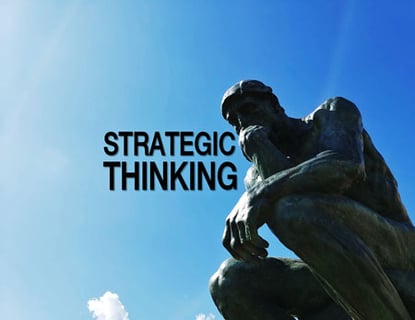“Inside the Executive Suite” from Armada Corporate Intelligence featured ideas keeping executives focused on strategic priorities during strategic planning meetings. If your team wanders away from the important strategic topic, here's a strategy to address it:
3 Ways to Keep Strategic Priorities Front and Center with Executives via Inside the Executive Suite
An executive reported a real-time challenge: keeping the senior team at her company focused on strategic priorities. Depending on the number of executives, or the positions of those prone to overly-detailed discussions, making sure a senior team does not get caught in the weeds during strategy meetings can be a touchy proposition.
We suspect it’s an issue familiar to many organizations. We find it typical that at least one or two individuals in any senior group are comfortable sticking to more detail than you would expect them to embrace. These may be individuals who are responsible for specific areas (and perhaps have been so throughout their careers) and/or ones with personalities oriented toward greater-than-average detail.
Keeping Strategic Priorities Front and Center
Do you struggle keeping senior-level strategy discussions at the appropriate level? If so, try these techniques we’ve employed over the years to focus meetings on strategic priorities that legitimately deserve executive suite attention.
1. Identify Where Everyone Stands Up Front
We are major proponents for meeting with executives before important strategy discussions. Whether through in-person interviews or some type of online input, it is helpful to know which executives are thinking what, and what issues resonate most strongly with them. Pre-meetings provide a sense of areas in which individuals may take the group into unnecessary detail. Questions to explore up front include:
- What are the most important issues to address?
- Where do you suspect strategy discussions could potentially derail?
- What factors are important for determining the right strategy?
- What topics do you feel most strongly about addressing in the meeting?
Based on participants’ answers, you will develop an early indication of the areas in which a meeting could go into the weeds. You will also have a sense of the major strategic themes to use in anchoring meeting conversations. Also, look for the senior leaders most likely to keep things out of the weeds. Talk with them beforehand, asking for their assistance to voice concerns if a particular leader or discussion becomes stuck in tactical matters.
2. Implement a Structure that Emphasizes Discussions on Strategic Priorities
Using what you identify during pre-meeting conversations, design a meeting format and structure to help the team focus on strategic issues. As you evaluate what is strategic, we recommend ignoring whether issues are long- or short-term. The timeline associated with acting on an opportunity or challenge doesn’t determine its strategic importance. Rather, think of strategic issues as those that will create a material impact on any of the following areas for your organization:
- Its brands
- Key audiences
- Customers and prospects
- Structure and alignment
- Financial prospects
- Vision and values
- Resources and raw materials
Sharing and adopting a comparable framework for what is strategic helps keep a discussion focused on matters that will legitimately move the needle in any of these areas.
We also use several other approaches to steer strategic conversations:
- List the major strategic themes you identify before the meeting. Allow the senior group to individually and collectively assign each item to a category: strategic, tactical, or (project) task issues.
- Assign time limits to various agenda topics, allowing more time for strategic matters—disproportionately so.
- As tactical or extraneous items are mentioned and commanding attention, stop and ask for clarification around the strategic issue to which they relate. If they can’t be tied back to strategy, table them.
- Tackle non-strategic topics with questions that reveal them for what they are. Ask: How does this contribute to accomplishing our major objectives? How will this create a meaningful impact for customers (or other audiences)? If we don’t address this at a senior level, what major downsides will it create?
You can use these techniques individually or in combination to help manage discussions toward a strategic level.
3. Actively Listening for Strategic Information
From our experience, it’s rare that senior leaders (or anyone else for that matter) will articulate clear strategy statements and strategic issues right away. Instead, strategy emerges from snippets of conversation. That places heavy responsibility on the meeting facilitator to listen for strategic inputs amid conversation that may largely seem tactical.
Beyond monitoring for the strategic areas we mentioned earlier, listen for any conversation that touches on:
- Organizational aspirations
- Expectations tied to strategic initiatives and outcomes
- Numbers that help size the impact of a strategic initiative
- Significant strengths and weaknesses
- Factors impacting organizational success, either positively or negatively
- Descriptions of metrics and objectives
- Beliefs central to the ways in which an organization conducts business
- Elements that will contribute to decision making
By identifying the types of information you need to develop and refine strategy, you can better recognize relevant elements that surface throughout a strategic discussion. When details emerge, record and organize them in a way that both highlights their strategic nature and provides a visual aid to align the group. We’ve used this technique to allow a leadership team the flexibility to talk in an open format, while capturing their strategic insights and organizing them in a way they can productively use. Another advantage to actively and distinctly posting strategic decisions and issues as you go through a meeting is that it creates a visual aid to manage the conversation. If people get in the weeds when trying to revisit previously-made decisions, you can point them to the decision list to demonstrate it has already been addressed.
Additionally, if several senior participants are struggling to stay on a strategic plane, divide the larger group into smaller sub-groups. Put tactical thinkers together, freeing those ready to stay focused on strategic topics and make progress.
Keep Trying
We’ve suggested various ideas for keeping strategic priorities a focus for executives . We’ve used them all successfully. Yet they won’t all work in every situation. Try them, adapt where you need to do so, and develop your own variations that work most successfully with your group of senior leaders. – via “Inside the Executive Suite”
If you enjoyed this article, subscribe to the free Brainzooming blog email updates.





